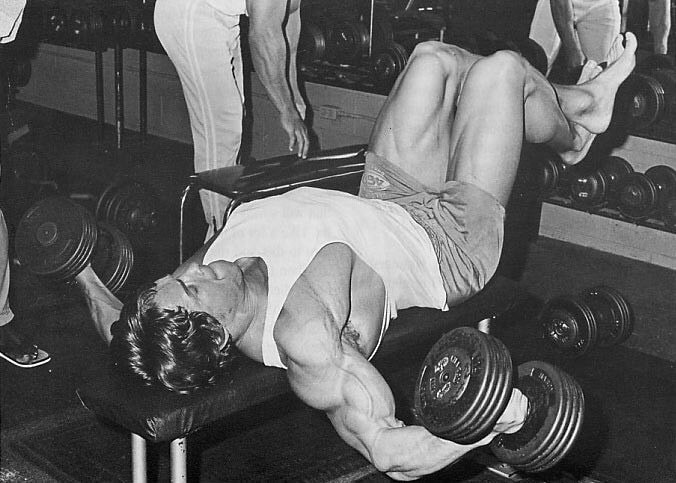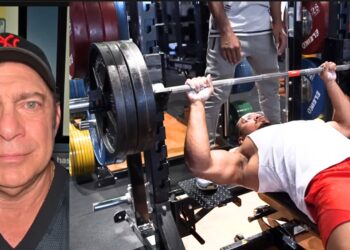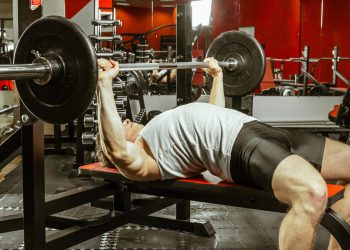The barbell bench press is the undisputed king of upper body exercises. Bodybuilders to it to increase pectoral development, while for powerlifters, it’s the second competitive lift. Gym goers all around the world to bench presses to sculpt the upper body of their dreams, and a big bench press invariably earns gym-bro bragging rights!
But, as great an exercise as the barbell bench press is, it’s easy to abuse. If all you ever do is bench press, your progress will eventually stall. Your muscles need more than simple overload to grow and get stronger; they need variety too.
That’s why smart lifters use a variety of chest-building exercises, involving changes in body angle (incline/decline) and different training tools (dumbbells, kettlebells, machines), as well as grip-widths.
Now there is another bench press variation you can add to your upper body exercise arsenal: The Larsen Press.
In this article, we reveal why and how to do this bench press exercise.
Larsen Press – Muscles Worked

The Larsen press is a compound exercise which means it involves multiple muscles and joints working together. The main muscles involved in this exercise are:
Level Up Your Fitness: Join our 💪 strong community in Fitness Volt Newsletter. Get daily inspiration, expert-backed workouts, nutrition tips, the latest in strength sports, and the support you need to reach your goals. Subscribe for free!
Pectoralis major – the large fan-shaped muscle on the front of your chest. Known as the pecs for short, the functions of this muscle are horizontal flexion, adduction, and medial rotation of the shoulder joint.
Anterior deltoid – the front of the three deltoid muscles, the anterior deltoid works alongside the pecs during flexion of the shoulder joint.
Triceps brachii – located on the back of your upper arm, and known as the triceps for short, this muscle extends your elbow.
Core – this is the collective term for the muscles that make up your midsection. Your core will have to work extra hard during the Larsen press to stabilize your lumbar spine and stop you from wobbling.
How to Do the Larsen Press
Get more from Larsen presses while keeping your risk of injury to a minimum by following these guidelines. Make sure you use a spotter for this exercise, or do it in a power rack with the safety bars set just above your chest.
- Lie on a flat bench with your eyes directly under the barbell. Reach up and hold the bar with an overhand, slightly wider than shoulder-width grip. Use a full grip and NOT a thumbless grip for safety.
- Pull your shoulders down and back and brace your core.
- Unrack the bar and hold it over your chest.
- Straighten your legs and lift your feet off the floor. If preferred, you can rest your feet on a conveniently positioned chair or a second bench.
- Bend your arms and lower the bar to your chest. Touch down lightly – no bouncing.
- Drive the weight back up to arms’ length and repeat.
- Focus on maintaining your balance, keeping your upper back tight, and ensuring that the bar remains level throughout each rep.
You can also do the Larsen press using a close grip to emphasize your triceps or a wide grip to emphasize your pecs. However, if you’re training to increase your bench press, use the same grip that you use for regular bench presses.
Larsen Press Benefits
Not sure if Larsen presses deserve a place in your workout? Consider these benefits and then decide:
A bigger bench press
Larsen presses were invented by elite powerlifter and bench press specialist Adrian Larsen. He was born with dislocated hips and club feet and underwent multiple corrective surgeries as a child. Larsen has won numerous powerlifting events, has held the 220-lb all-time bench press world record, and has benched over 700lbs in competition.
The Larsen press is how Adrian Larsen lifts in competition. He also believes it’s one of the reasons he’s such a prolific presser. It provides an easy way to increase the difficulty of the bench press without adding more weight to the bar or utilizing things like bands or chains.
More force without the leg drive
Top powerlifters use their legs during bench presses. This allows them to lift more weight. Taking your legs out of the bench press teaches you to rely more on your upper body.
Then, when you return to using leg drive, you should find you can use your lower body more effectively. It’ll undoubtedly make you appreciate how important the legs are for a big bench press.
Increased upper back tightness
A lot of lifters think the bench press is a chest exercise, and they’re right. But, the upper back is also important, as it provides you with a solid base from which to press and stabilizes your shoulders. With your feet off the ground, Larsen presses force you to be more conscious of your back’s role in the bench press. You MUST keep your upper body tight to remain stable as you won’t be able to rely on your legs.
Increased muscle activation
In studies, doing bench presses with your feet off the floor can increase pectoralis major, anterior deltoid, and triceps engagement. This means the Larsen press may help you build muscle more effectively than regular bench presses.
Better control and balance
With your feet raised, you’ll need to pay more attention to controlling and balancing the bar than with regular bench presses. You’ll need to do your reps smoothly and without bouncing the bar off your chest. This should lead to better bench press technique and safer workouts.
Larsen Press Drawbacks
While Larsen presses are a mostly beneficial exercise, there are also a few drawbacks to consider:
Increased injury risk
Benching with your feet off the floor means you could easily lose your balance and lose control of the bar. For that reason, the Larsen press should always be done with a spotter on hand or in a power rack.
No lower back arch
Whether you are a powerlifter or a bodybuilder, you generally need a lumbar arch to bench press well. Arching your lower back increases core and upper back activation, provides stability and helps to set your shoulders.
With your legs extended, you are more likely to flatten your back and lose these advantages. That’s okay if you are doing Larsen presses occasionally and with lighter than normal weights. Still, it could be an issue if you do this exercise more frequently.
Lift less weight
The Larsen press clearly works brilliantly for Adrian Larsen. But, for most people, no leg drive means you won’t be able to list as much weight as usual. This could mean the Larsen press is not as effective as regular bench presses for some people.
When to Use the Larsen Press
The Larsen press is an excellent bench press accessory exercise that could help improve your bench press performance. It’s also a useful bodybuilding exercise as it may increase muscle engagement, leading to increased pec hypertrophy.
While you could just do the Larsen press instead of bench presses, you’ll probably get better results if you incorporate into your workouts. For example:
Hypertrophy
- Larsen press – 4 sets of 6-8 reps
- Incline dumbbell bench press – 3 sets of 8-12 reps
- Cable crossovers – 2 sets of 12-15 reps
- Push-ups – 1 set of max reps
Strength
- Larsen press – 6 sets of 3 reps
- Wide grip barbell bench press – 3 sets of 5 reps
- Weighted dip – 3 sets of 8 reps
Powerbuilding (hypertrophy & strength)
- Larsen press – 5 sets of 5 reps
- Incline barbell bench press – 3 sets of 6 reps
- Dumbbell bench press – 3 sets of 8 reps
Ultimately, like any exercise in your workouts, you’ll get better results from the Larsen press by adapting it to meet your training goal.
7 Larsen Press Alternatives and Variations
The Larsen press is a highly effective upper body exercise, but that doesn’t mean you need to do it all the time. There are several variations and alternatives you can use to keep your workouts productive and interesting:
1. Dumbbell Larsen press
No barbell? No problem! You can also do the Larsen press with dumbbells. Use a regular or neutral grip as preferred. The neutral grip is arguably more shoulder-friendly but may not be as effective for engaging the pecs. However, you’ll need to work extra hard to stabilize and control two dumbbells instead of a single barbell.
Level Up Your Fitness: Join our 💪 strong community in Fitness Volt Newsletter. Get daily inspiration, expert-backed workouts, nutrition tips, the latest in strength sports, and the support you need to reach your goals. Subscribe for free!
2. Floor press
Floor presses can be done with your legs bent, feet flat on the floor, or legs straight. The latter makes floor presses feel a lot like the Larsen press. Because you cannot lower the bar as far, the floor press with legs extended is a very joint-friendly exercise that powerlifters often turn to when bench presses cause shoulder pain. Floor presses can also be done using dumbbells.
Read more about floor presses in our detailed guide.
3. Paused bench press
Like the Larsen press, the paused bench press requires no additional equipment or angled benches. That means you can easily use it to add some variety to your bench press workouts. Pausing mid-rep increases time under tension, which is good for hypertrophy.
It also eliminates momentum and reduces the effect of the stretch reflex, and that’s useful for building strength.
How to do it:
- Lie on your bench with your eyes beneath the bar. Plant your feet firmly on the floor. Brace your abs. Reach up and grab the bar with an overhead, slightly wider than shoulder-width grip. Pull your shoulders down and back.
- Un-rack the bar and hold it over your chest. Bend your arms and lower the bar under control to your sternum. Pause for 2-5 seconds without relaxing or resting the bar on your chest.
- After your pause, drive the bar up as powerfully as you can and then repeat.
- You can apply this pausing method to many of the following bench press variations.
3. Bench press with bands or chains
Using bands or chains with free weights is called accommodating resistance. These training tools increase the load as you extend your arms and approach lockout. This can be useful for overloading your triceps, taking stress off your shoulders, or increasing explosive power as you drive the bar up and off your chest.
While some gyms have chains, bands are arguably the most convenient way to do accommodating resistance bench presses as they’re light, portable, and affordable.
How to do it:
- Attach a loop-type resistance band to your barbell and then secure it to the floor using a heavy dumbbell. Some power racks and bench press stations have pegs for this purpose.
- Unrack the bar as usual and lower it to your chest. Work hard to control the descent, and don’t let the bands snap it down toward your chest.
- Pause for a second and then drive the bar up to arms’ length.
4. Guillotine press
Vince Gironda was one of the most influential trainers in bodybuilding history. As well as being an accomplished bodybuilder himself, Gironda worked with Mr. Olympia winners and the Hollywood elite during the late 1960s, 70s, and early 80s.
Known as the Iron Guru, Gironda believed that the regular bench press was not a very effective chest builder, stating it worked the shoulders more than the pecs. In response, he developed a bench press variation that involved more pec engagement – the Gironda guillotine press.
This exercise has fallen out of favor over the last few decades, but it’s still an effective chest builder. However, because it’s a somewhat risky exercise (you lower the bar to your neck!), you should always do the Gironda guillotine press with a spotter or in a power rack.
Learn how to do the Gironda guillotine press here.
5. Spotto press
Like the Larsen press, Spotto presses are named after a champion bench presser. In this instance, it’s champion powerlifter and arm-wrestler, Eric Spoto. As with exercise #3, the Spoto press involves a mid-rep pause. However, for this variation, you stop the bar 3-6” above your chest instead of touching it.
The Spoto press increases time under tension for hypertrophy. It also breaks up the eccentric/concentric contraction cycle, so you have to work harder to drive the weight back up. This is useful for developing strength and power.
Learn more about the Spotto press in this in-depth guide.
6. Earthquake bench press
Like Larsen presses, this bench press variation creates a lot of instability, so the bar shakes in your hands. This challenges and develops better joint stability and also increases pec engagement.
You can use a special earthquake flexible bar made or just hang weights from a standard Olympic barbell using resistance bands. Either way, this is a challenging bench press variation, so don’t go too heavy too soon.
7. Eccentric emphasis bench press
A lot of benchers lower the bar too fast and then all-but bounce it off their chests. While such a maneuver may allow you to lift more weight or complete more reps, it’s basically a form of cheating and actually takes stress off the target muscles. It’s also VERY dangerous for your sternum, ribs, and shoulders.
Instead of seeing how fast you can drop the bar, try lowering it extra-slow. Eccentric emphasis bench presses force you to lower the bar under control, increasing time under tension.
To do this simple variation, unrack the bar as usual and then lower it to your chest for a slow count of three. You can then either pause and press or lightly touch and go as preferred. With touch-and-go bench presses, there is no noticeable pause between the eccentric and concentric portions of the lift.
A slow eccentric also means that you’ll get a better workout from lighter weights, which is helpful if heavy loads hurt your joints.
Larsen Press – Wrapping Up
Back in the golden era of bodybuilding, guys like Arnold Schwarzenegger and Franco Columbu were often seen training their chests with their feet off the floor. They believed that this technique increased muscle engagement, which is something science has since confirmed.
However, some functional fitness naysays are often very quick to say that feet-up bench pressing was dangerous. However, strength coach Charles Poliquin went as far as to say that anyone benching this way was “a future orthopedic patient.”
We’ve now come full-circle, and benching with your feet up is acceptable again, all thanks to powerlifter Adrian Larsen.
The Larsen press is a valuable exercise, but it’s not the be-all and end-all of bench press variations. It could help you build a bigger chest or increase your bench press, but it’s not right for everyone. It’s just one of many exercises you can use to reach your training goals.
So, how do you know if the Larsen press deserves a place in your workouts? Try it! After a couple of months of Larson presses, if you aren’t benching more weight or your chest is no bigger, go back to regular bench presses.
References:
1– PLOS (Public Library of Science): Evaluation and comparison of electromyographic activity in the bench press with feet on the ground and active hip flexion https://journals.plos.org
Interested in measuring your progress? Check out our strength standards for Bench Press, Push Ups, Floor Press, and more.









